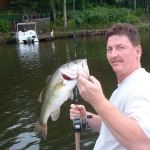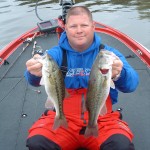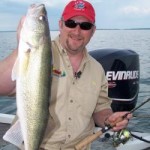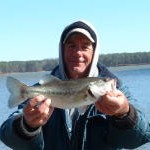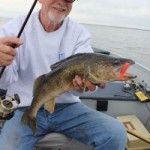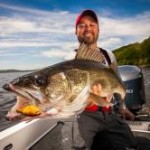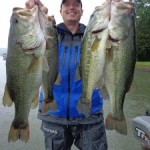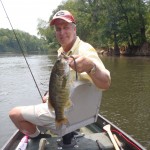Ponds warm faster in the early spring than bigger bodies of water for several reasons. Their size protects them from wind stirring them up like it does the bigger lakes, and shoreline trees often give even more protection. Less mixing of the water from wind allows the surface of the pond to warm and stay warm faster.
Shallows in ponds often have dark bottoms from sediment and this absorbs sunlight and warms the shallows faster. On big lakes waves usually washed away the darker sediment leaving sand and gravel that does not absorb heat as well.
Most ponds have more shallow water relative to size than the bigger lakes, so they have more area to warm more quickly. And vegetation growing in the shallows help absorb heat, adding to the warming. All these factors mean ponds warm more quickly than bigger lakes.
Bass respond to warming water in ways to make any fisherman smile. As soon as the water starts a warming trend and gets above about 50 degrees the bass will go to shallow water and feed. This movement makes them much easier to catch on a variety of baits and they are feeding heavily.
To catch these early spring active bass target water less then six feet deep. Don’t hesitate to cast right to the bank in less than a foot of water. Bass will get in water that barely covers their backs this time of year. That is where the water is most warm and they are most likely to find food.
Fish all shallow water in a pond. On the first warm days in early spring the bass might move into contact with the bank near deeper water at the dam. After two or three days of warm sun they will be in shallows far from the deeper water, often in the very far upper end of the pond.
Any kind of shallow cover will hold bass. Target early growing vegetation, old weeds that have not rotted away, brush, trees in the water, overhanging bushes and rocks. Bass tend to hold tight against cover but are willing to ambush any bait fairly close to them. Your cast should be past the cover, bring your bait back by it, when possible.
A spinnerbait is hard to beat in the early spring. Use a fairly small bait like a three-sixteenths ounce bait with a willowleaf blade and a smaller Colorado blade. Colors depend on water clarity but a standard that works well is a chartreuse skirt with one gold blade and one silver blade. Adding a curly tail trailer gives it more action and allows you to fish the bait more slowly, too.
The reason a spinnerbait is so good is you can fish it at any speed and fish water from the surface to the bottom. On warmer days buzz the bait just under the surface, reeling it fast over any cover you see. For a change-up stop the bait and let it fall by a stump or other wood cover, then start reeling it fast again, if a bass has not already inhaled it.
Slow down and reel the bait a foot or so under the surface, with pauses and twitches to make the skirt flare and the blades flutter. Fish from right on the bank all the way out to six feet deep. If fishing from the bank, make parallel casts to the bank, fan casting from right against the edge to angles that put the bait in deeper water.
Very early in the spring, when the water first starts to warm, try slow rolling the spinnerbait, crawling it along the bottom. You want to fish the bait as slowly as you can to keep the blades turning. Let the bait bump anything on the bottom but keep it moving slowly and steadily.
A soft jerk bait like the Zoom Fluke will get bit when other baits are passed up in small ponds in the early spring. Rig the bait weightless and cast it to the edge of the water. Work it back with soft twitches, making it look like an injured minnow that is struggling to swim. Bass find such an easy meal hard to pass up.
A light colored bait like albino or natural blue is easier to see in the water and you can tell when a bass takes it. Watch your bait and line and set the hook when anything unusual happens, like a line twitch or if your bait suddenly disappears.
A jig and pig is an excellent bait early in the spring, too. As soon as the water starts to warm crayfish come out of their tunnels where they spent the winter and bass love them. Clay and rock banks are best for imitating crayfish, but a jig and pig will work anywhere.
In clear water use browns and greens, like a brown jig with a green pumpkin trailer. For stained water tie on a black and blue jig with a blue trailer. Use a realistic crawfish looking trailer or a simple twin tail curly tail trailer. The curly tail trailer has more action and makes the bait fall slower, too.
Use a fairly light jig, three-sixteenths to one quarter ounce, and stick to smaller size trailers and skirts, too. Cast the bait right to the bank and crawl it along the bottom with small hops. If you have ever watched a crawfish feeding it will crawl along then suddenly jump several inches, especially when startled. Make your bait look like a crawfish feeding.
Cover clay and rock areas with many casts, but also cast to any wood cover you find. Try to skip the bait under overhanging bushes right to the bank, let it sit a few seconds then slowly work it out. Keep your line tight and be ready to set the hook at any mushy feeling or thump on your line.
Small crankbaits are good in ponds in early spring, too. Use a shallow running bait that will dig down to six feet deep, like the two inch Spro Little John, and try colors that imitate a bluegill, like the Sunny Bream. Bass feed heavily on bluegill in ponds and they are common in almost all ponds.
Make fairly long cast in clear water and fish the bait so it bumps the bottom from right on the bank out to six feet deep. Try different speeds, from a fast retrieve for active fish to a slow crawl that looks like a meal too easy to pass up. When you hit bottom pause and let the bait float up a little, then dig it down again.
Its hard to beat a small pond for bass this time of year. Give them a try to catch more and bigger bass.
